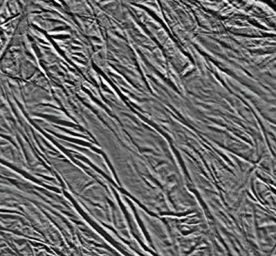
|
Groovy Enceladus
- Click the image above for a larger view
 Movie Download Options
Movie Download Options- Full-Res JPEG (619 x 573) (98.5 kB)
- Full-Res TIFF (619 x 573) (1.1 MB)
Caption:
This image shows grooves in the southern part of Saturn's moon Enceladus. The image was created using synthetic-aperture radar (SAR) data acquired by NASA's Cassini spacecraft on Nov. 6, 2011. The radar image is overlaid in light blue over an earlier visible-light image ( PIA08342 ). The SAR swath shown is 15.5 miles (25 kilometers) wide and provides a close-up view of the grooved, water-ice bedrock present in this region. This region is a few hundred miles north of the vents from which plumes of water vapor and icy material have been previously detected ( PIA11696 ). The image is centered at 65 south latitude and 293 west longitude.
Both visible-light and SAR images show the shape of features and give information about the features' composition. But whereas visible-light images (like we normally see in photographs) tell us about chemical composition, SAR images tell us about electric properties. Electric properties help us distinguish one material from another. Here, shadowing in this SAR imagery also emphasizes smaller undulations in the surface interspersed in the terrain surrounding the large groove. These appear to be relatively young features that may have formed from extension, or pulling apart, of Enceladus' crust due to effects of Saturn's gravity. Since the radar illumination is from the upper right (perpendicular to the swath), the upper slopes of grooves are dark and the lower (left) slopes are bright. Analysis of the slopes and their shading reveal that the central, prominent groove is about 2,100 feet (650 meters) deep and 1.2 miles (2 kilometers) wide, with slopes of about 33 degrees.
This large groove is similar to Enceladus' famous "tiger stripes." These large fractures are the source of the jets of icy particles and water vapor that erupt from the moon's southern polar region. They are much warmer than the rest of the moon's surface, indicating a subsurface source of heat.
These images of Enceladus show some similarity to those obtained of Saturn's largest moon Titan. Titan's large feature Xanadu ( PIA08428 ) is also very bright, as are areas surrounding the crater Sinlap ( PIA07868 ). Whether the bright areas seen here are due to the same, or very different, processes will be a subject of discussion as scientists continue to learn more about the moons of Saturn.
Background Info:
The Cassini orbiter was designed, developed and assembled at JPL. The radar instrument was built by JPL and the Italian Space Agency (ASI), working with team members from the U.S. and several European countries. JPL is a division of the California Institute of Technology in Pasadena.
For more information about the Cassini-Huygens mission visit http://saturn.jpl.nasa.gov and http://www.nasa.gov/cassini . The Cassini imaging team homepage is at http://ciclops.org .
Cataloging Keywords:
| Name | Value | Additional Values |
|---|---|---|
| Target | Enceladus | Saturn, Titan |
| System | Saturn | |
| Target Type | Satellite | Planet |
| Mission | Cassini-Huygens | |
| Instrument Host | Cassini Orbiter | |
| Host Type | Orbiter | |
| Instrument | Synthetic Aperture Radar (SAR) | |
| Detector | ||
| Extra Keywords | Color, Crater, Movie, Plume, Radar, Shadow, Water | |
| Acquisition Date | ||
| Release Date | 2011-12-01 | |
| Date in Caption | 2011-11-06 | |
| Image Credit | NASA/JPL-Caltech/ASI/Space Science Institute | |
| Source | photojournal.jpl.nasa.gov/catalog/PIA15171 | |
| Identifier | PIA15171 | |
